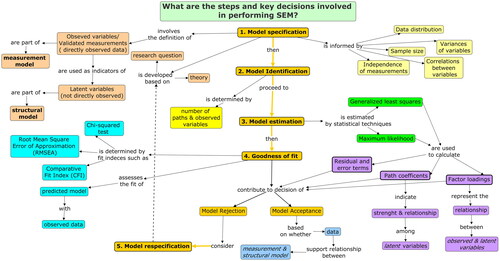Structural equation modeling (SEM) is a statistical method that allows for the testing of the direct and indirect relationships between multiple variables in a single model. It integrates factor analysis, which can be thought of as the measurement portion, and path analysis, which can be thought of as the structural part of the analysis. In the measurement portion, observed data (e.g. test item scores) can be used as indicators of latent variables, which are constructs that can’t be measured directly (e.g. self-regulated learning). In the structural part, SEM indicates the magnitude, direction, and significance of the direct and indirect relationships between the variables, whether they are endogenous or exogenous, in the model. SEM also provides an estimate of the overall fit of the model. When interpreting the results of a SEM analysis, both the model fit indices and the indicators of the relationships between the variables and constructs should be considered (Kremelberg Citation2011; Kline Citation2015). SEM is an iterative process that consists of five steps: model specification, identification, model estimation, goodness of fit determination, and model respecification (Violato and Hecker Citation2007). The concept map presented in figure one highlights the critical steps and decisions that researchers utilize when conducting a SEM analysis. To perform these steps properly, the researcher has to make several informed decisions and considerations based on the theory and research question that they are evaluating, the data that is available, and the characteristics/properties of SEM as an analysis technique (Violato and Hecker Citation2007; Kline Citation2015). Some of these decisions and considerations include:
Choice of theory: SEM should be used to test models that are strongly informed by theory and previous empirical research.
Choice of model description: Generally speaking, the simplest model that is based on theory and that adequately fits the data should be chosen. Although adding variables and relationships to the model can result in better test statistics, if these variables and relationships do not improve the interpretability of the model, the researcher would be advised to present the simpler, more parsimonious model (Kremelberg Citation2011).
Selection of validated measurement with specific questionnaires: SEM can confirm how variables are composed of their subscales and items. However, SEM cannot assess the validity of measurement scales or compensate for poor validity in measurement.
Sampling: In order to estimate the size of the sample required for conducting a SEM analysis, one should be cognizant of the rule of thumb that proposes a minimum ratio of 10–25 subjects for each estimated parameter in the model (Violato and Hecker Citation2007).
Choice of model estimators: As with all multi-variate analysis techniques, the data should be screened before analysis to check whether the assumptions for conducting SEM, such as normality, linearity, etc. are met. If any of the assumptions are violated, the choice of the model may need to be reconsidered.
Choice of fit indices and cut-off scores: Before testing a model, the researcher should justify the cut-off scores for the fit indices by which the model will be accepted (Hu and Bentler Citation1999).
SEM analysis was used in the paper by Stoffels et al. (Citation2023), who used the technique to test two hypotheses related to the relationships between learning climate, self-regulated learning behavior, perceived learning, and basic psychological needs satisfaction among a sample of 244 undergraduate nursing students. The concept map in highlights the critical steps to perform SEM (Violato and Hecker Citation2007).
Disclosure statement
No potential conflict of interest was reported by the author(s).
Additional information
Funding
Notes on contributors
Malou Stoffels
Malou Stoffels is a postdoctoral researcher at Amsterdam UMC, location Vrije Universiteit Amsterdam, team Research in Education, Amsterdam, the Netherlands.
Dario M. Torre
Dario M. Torre is Professor of Medicine, Dept of Medical Education at University of Central Florida, College of Medicine, Orlando, Florida, USA.
Paul Sturgis
Paul Sturgis is Manager of Analytics, at University of Central Florida, College of Medicine, Orlando, Florida, USA.
Andries S. Koster
Andries S. Koster is an associate professor of pharmacology at Utrecht University, Utrecht, the Netherlands.
Marnix P. D. Westein
Marnix P. D. Westein is a PhD student in pharmacology education at Utrecht University, Utrecht, the Netherlands.
Rashmi A. Kusurkar
Rashmi Kusurkar is a professor of Medical Education at Amsterdam UMC, Vrije Universiteit Amsterdam, Amsterdam, the Netherlands.
References
- Hu L, Bentler PM. 1999. Cutoff criteria for fit indexes in covariance structure analysis: conventional criteria versus new alternatives. Struct Equ Model. 6(1):1–55. doi: 10.1080/10705519909540118.
- Kline RB. 2015. Principles and practice of structural equation modeling. New York: Guilford Publications.
- Kremelberg D. 2011. Practical statistics: a quick and easy guide to SPSS Statistics, STATA, and other statistical software. Thousand Oaks: SAGE.
- Stoffels M, Koster AS, van der Burgt SM, de Bruin AB, Daelmans HE, Peerdeman SM, Kusurkar RA. 2023. Basic psychological needs satisfaction as a mediator between clinical learning climate, self-regulated learning and perceived learning in the nursing education context. Med Teach. 2023:1–9. doi: 10.1080/0142159X.2023.2225729.
- Violato C, Hecker KG. 2007. How to use structural equation modeling in medical education research: a brief guide. Teach Learn Med. 19(4):362–371. doi: 10.1080/10401330701542685.

